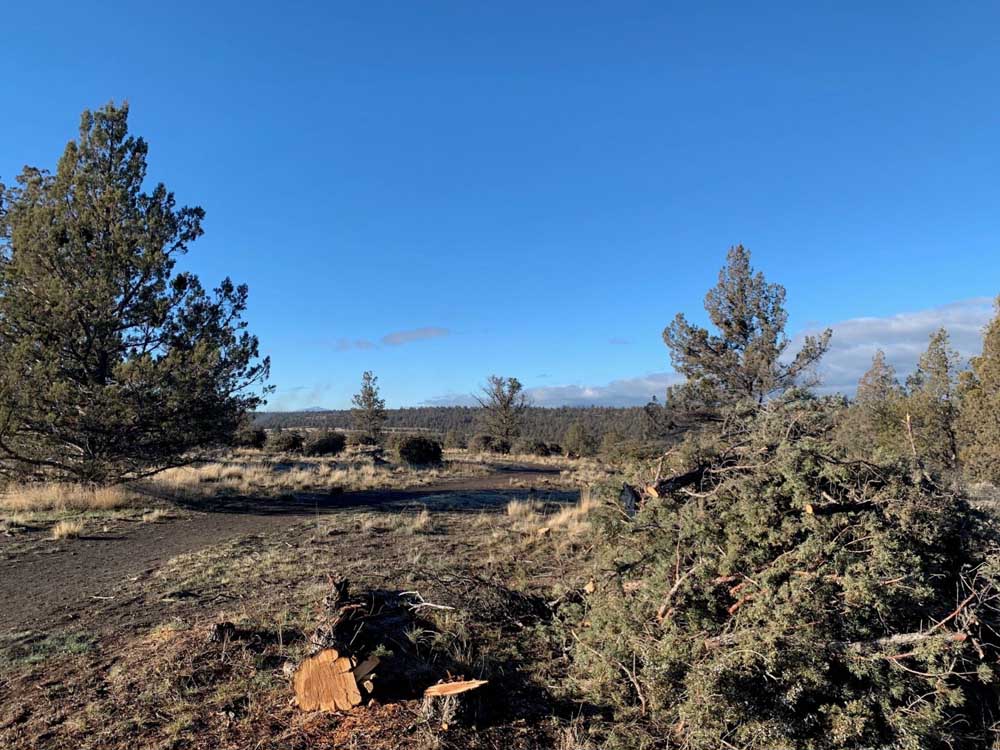As junipers expand their Central Oregon range, trees draw both ire and respect of residents
Published 1:30 am Tuesday, January 3, 2023

- FILE- Crews cut juniper trees and mowed grass and shrubs near Crooked River Ranch as part of a 622-acre juniper-thinning project this fall.
Pictures of Prineville circa 1880 show a sea of grass and very few trees — an expanse that drew ranchers by the hundreds to settle in central Oregon.
Today, like much of the eastern and central Oregon sagebrush sea, the steppe is covered with juniper tress and — more worrisome — cheatgrass. Closer to Redmond there were just as few trees, mostly desert.
The western juniper is native to Oregon, with frequent references to it being a weed. In the 1870s, settlers raised large numbers of cattle that feasted on the native grasses growing among the sagebrush. Only 3 to 5 percent of the juniper currently surrounding Redmond was there during frontier days.
More than one million acres of sagebrush grazing lands in Oregon have turned into pinyon-juniper forests in the past two decades alone. This slow but steady invasion is largely a result of how we’ve changed the way grasslands are managed.
Unlike the settlers, Native Americans used to set fire to grasslands to keep them open. No longer. We do our best to suppress fires because they threaten livestock and property. This suppression soon allowed junipers to expand from their steep, rocky sanctuaries. Across central Oregon, juniper populations have exploded in the last century. Today, juniper range is expanding by roughly 1.5 percent per year — even encroaching on pine forests near Redmond.
Deschutes County Commissioner, Patti Adair, has made juniper removal a must on her to-do list following her re-election last month.
Juniper trees outcompete the grasses and shrubs of the sagebrush steppe. In extreme cases, nothing but bare soil and shallow-rooted invasive grasses remain between the trees, dramatically decreasing habitat quality for many species. Sagebrush-dependent songbirds like the Brewer’s sparrow and the green-tailed towhee have nowhere to nest.
Bighorn sheep and pronghorn antelope become more vulnerable to mountain lions, which use junipers as cover to stalk large prey. Raptors perch in juniper branches to prey on sage grouse — a bird who evolved in large and treeless landscapes.
Sage grouse avoid mating or nesting if there are more than a couple trees on the landscape, likely because conifer woodlands are riskier habitats for grouse with more predators.
Water hogs
Juniper reduce water availability in our drought stricken landscape. One tree can suck up to 40 gallons of water a day from the arid desert soil.
“Such profligate consumption can squeeze grass production to 100 pounds per acre in areas that otherwise produce 1,000 pounds,” said Tony Svejcar, a lead scientist at the U.S. Department of Agriculture.
While this affects native wildlife, it’s had an even greater impact on the cattle ranchers who for generations have come to depend on the sagebrush ecosystem’s natural resources.
As water and native grasses become scarce, the number of cattle a piece of land can support plummets. Depending on the site and how advanced the juniper growth is, the tree’s invasion can decrease the amount of forage by 30 to 90 percent. The Oregon Cattlemen’s Association has called juniper “one of our most noxious invasive species.”
Fire spreaders
Young juniper carry flames during range fires. But as they age, junipers dry out the soil so desert grasses and sagebrush disappear, leaving deer and elk with little to eat and no ladder fuels to carry a range fire, say biologists, who also believe it causes steep-slope erosion.
Juniper long ago dried up many of the bubbling desert springs where homesteaders built cabins.
Historic icons
Junipers are simultaneously revered and reviled. The juniper tree symbolizes strength, wisdom, usefulness and beauty. The strength of the juniper tree is seen in its capacity to survive in harsh and bare climates, growing out of rocks and surviving in areas with very little water.
The wisdom of junipers is seen in its ability to live in almost every continent in the world. It is one of the oldest living species of tree.
The oldest living juniper in the U.S., the Bennett Juniper in Northern California, is thought to be 6,000 years old. Junipers have the capacity to self-prune, shedding branches for survival, and its sap is rot resistant.
In 2016, a few miles east of Bend, a juniper thought to be 1,000 years old was illegally poached and is probably home décor today.
Near Fort Rock, a little over an hour from Redmond, is a living specimen believed to be more than 1,600 years old. Its exact location is not on any map, for fear of vandalism or worse. Cutting one down on public land is punishable by a fine of $100,000 and up to a year behind bars.
Despite their longevity, junipers rarely exceed 30 feet in height or three feet in diameter.
Juniper berries and sap have been used medicinally in Chinese and Native American cultures and the berries supply food and shelter for native animals. Early pioneers and cowboys used juniper trees in both homebuilding, and using its soft bark to make bedding and even toilet paper.





